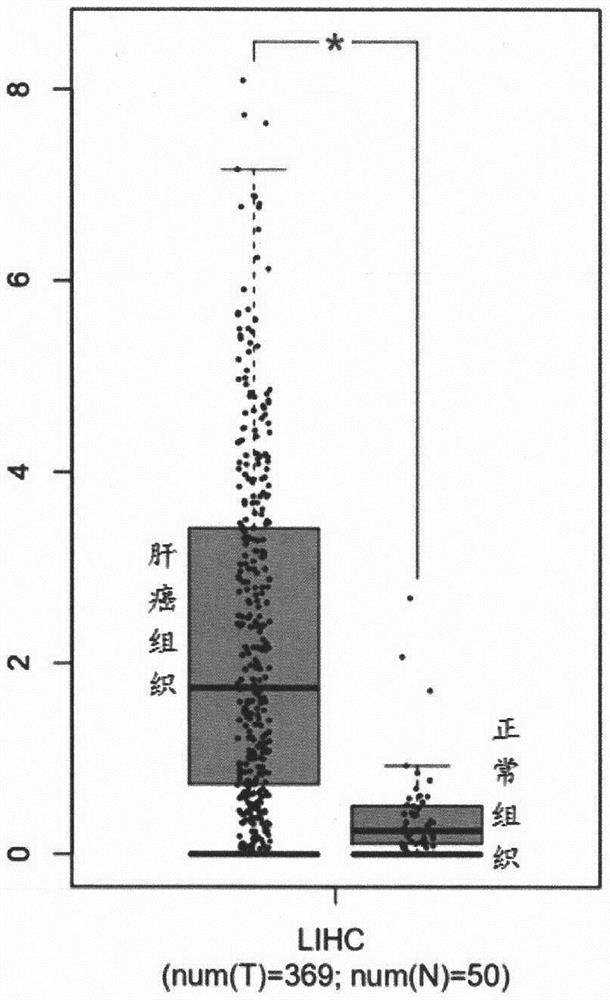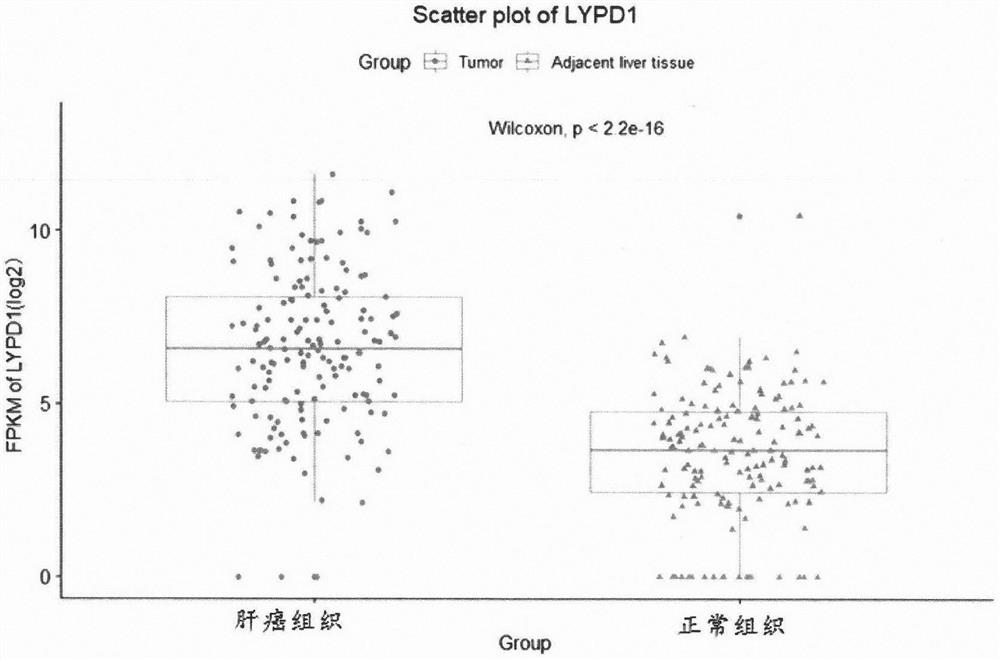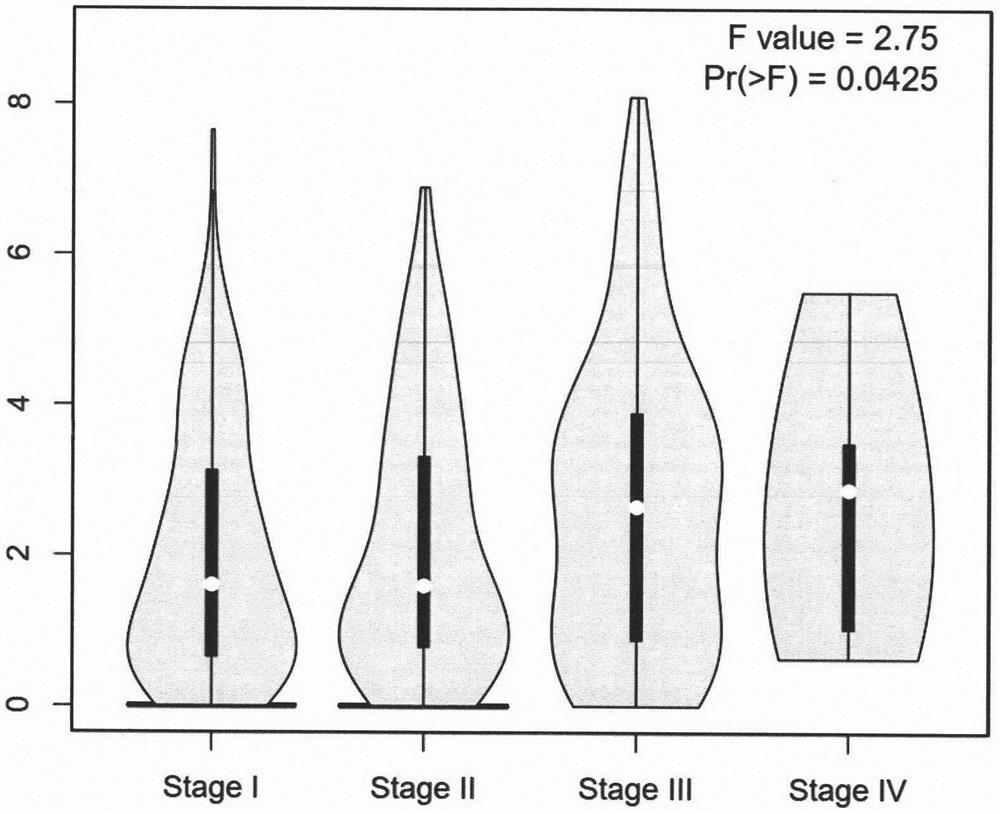Application of LYPD1 in diagnosis, treatment, prognosis and recurrence prediction of hepatocellular carcinoma
A technology in liver cancer and samples, applied in the field of biomedicine, can solve the problems of limited and immature liver cancer markers
- Summary
- Abstract
- Description
- Claims
- Application Information
AI Technical Summary
Problems solved by technology
Method used
Image
Examples
Embodiment 1
[0029] By analyzing the TCGA database, the inventor found that the gene LYPD1 was significantly highly expressed in liver cancer tissue compared with normal liver tissue, and was closely related to cancer stage. The specific operation is as follows:
[0030] 1. TCGA database analysis
[0031] Methods: 419 samples (369 cases of liver cancer tissue and 50 cases of normal liver tissue) in the TCGA database were analyzed, and the expression level of LYPD1 in each sample was calculated by log 2 (TPM+1) is displayed in the form of points in the figure after normalization, and the box plots formed by different groups of points are distinguished by left and right, the box plot of liver cancer tissue is on the left, and the box plot of normal tissue is on the right . The upper and lower edges of each box plot represent the maximum and minimum values of LYPD1 expression in the corresponding group, and the upper and lower sides of the box represent the upper and lower quartiles of LYP...
Embodiment 2
[0040] The inventors found that in patients with advanced liver cancer treated with hepatic arterial infusion of FOLFOX, the expression level of LYPD1 significantly affects the curative effect of treatment, and the overall evaluation of treatment response in patients with high expression level of LYPD1 is significantly better than that in patients with low expression level of LYPD1.
[0041] Methods: A retrospective study was used to analyze the clinical data of 40 patients with advanced hepatocellular carcinoma who were admitted to the Department of Hepatobiliary and Pancreatic Surgery of Sun Yat-sen University Cancer Center and received HAIC from February 2016 to April 2018. Tissue RNA was extracted from the puncture specimens of these patients before HAIC treatment, and RNA sequencing was performed. According to the tumor response after HAIC treatment (RECIST standard), they were divided into a tumor progression (PD) group and a non-tumor progression (PR) group, and the diff...
Embodiment 3
[0043] Example 3: The correlation between the expression level of LYPD1 and the prognosis of patients with advanced liver cancer using the hepatic artery infusion FOLFOX regimen
[0044] 1. The expression level of LYPD1 was significantly positively correlated with the overall survival of patients with advanced liver cancer treated with hepatic arterial infusion of FOLFOX regimen.
[0045] Methods: Using the method of retrospective study, 40 patients were divided into two groups with high expression of LYPD1 and low expression of LYPD1, taking the median of LYPD1 expression as the boundary. All statistical analyzes were processed with SPSS25.0 statistical software. The Kaplan-Meier method was used to draw the survival analysis curve, and the log-rank test was used to detect the statistical significance. A test coefficient of P<0.05 was considered statistically significant. SPSS statistical software was used to analyze the relationship between the expression of LYPD1 and the o...
PUM
 Login to View More
Login to View More Abstract
Description
Claims
Application Information
 Login to View More
Login to View More - R&D
- Intellectual Property
- Life Sciences
- Materials
- Tech Scout
- Unparalleled Data Quality
- Higher Quality Content
- 60% Fewer Hallucinations
Browse by: Latest US Patents, China's latest patents, Technical Efficacy Thesaurus, Application Domain, Technology Topic, Popular Technical Reports.
© 2025 PatSnap. All rights reserved.Legal|Privacy policy|Modern Slavery Act Transparency Statement|Sitemap|About US| Contact US: help@patsnap.com



